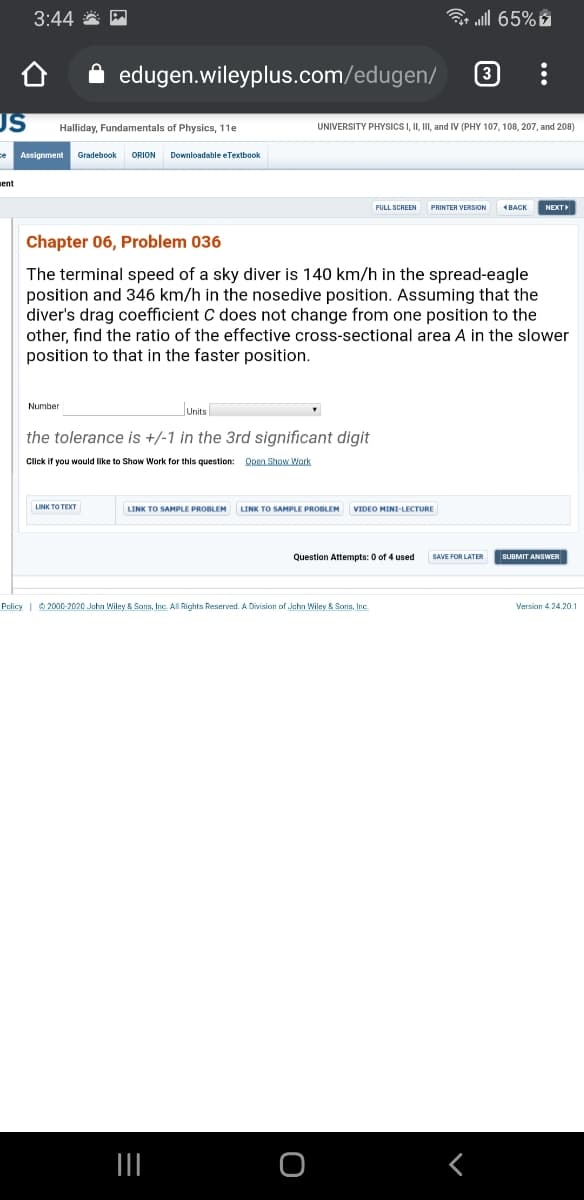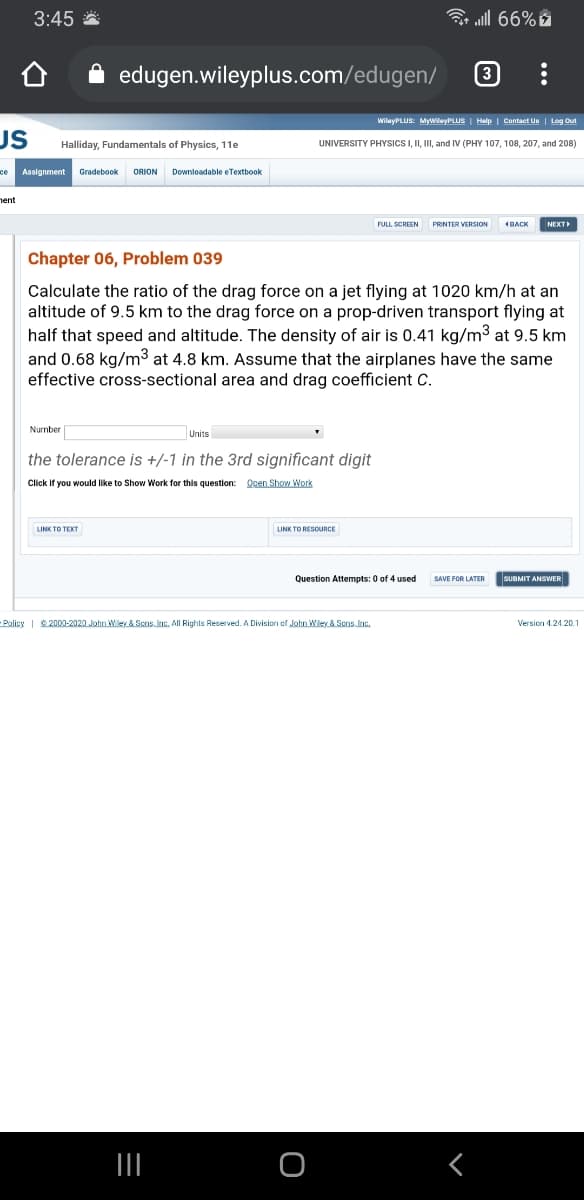The terminal speed of a sky diver is 140 km/h in the spread-eagle position and 346 km/h in the nosedive position. Assuming that the diver's drag coefficient C does not change from one position to the other, find the ratio of the effective cross-sectional area A in the slower position to that in the faster position.
The terminal speed of a sky diver is 140 km/h in the spread-eagle position and 346 km/h in the nosedive position. Assuming that the diver's drag coefficient C does not change from one position to the other, find the ratio of the effective cross-sectional area A in the slower position to that in the faster position.
Physics for Scientists and Engineers
10th Edition
ISBN:9781337553278
Author:Raymond A. Serway, John W. Jewett
Publisher:Raymond A. Serway, John W. Jewett
Chapter38: Relativity
Section: Chapter Questions
Problem 41P: Review. A global positioning system (GPS) satellite moves in a circular orbit with period 11 h 58...
Related questions
Question
please need the question to be answered now

Transcribed Image Text:3:44 *
3 all 65%
edugen.wileyplus.com/edugen/
3
S
UNIVERSITY PHYSICS I, II, III, and IV (PHY 107, 108, 207, and 208)
Halliday, Fundamentals of Physics, 11e
Assignment
Gradebook
ORION
Downloadable eTextbook
ment
FULL SCREEN
PRINTER VERSON
NEXT
(BACK
Chapter 06, Problem 036
The terminal speed of a sky diver is 140 km/h in the spread-eagle
position and 346 km/h in the nosedive position. Assuming that the
diver's drag coefficient C does not change from one position to the
other, find the ratio of the effective cross-sectional area A in the slower
position to that in the faster position.
JUnits
Number
the tolerance is +/-1 in the 3rd significant digit
Click if you would like to Show Work for this question: Open Show Work
LINK TO TEXT
LINK TO SAMPLE PROBLEM
LINK TO SAMPLE PROBLEM
VIDEO MINI-LECTURE
Question Attempts: 0 of 4 used
SAVE FOR LATER
SUBMIT ANSWER
Policy | 2000-2020 Jahn Wiley & Sons, Inc. All Rights Reserved. A Division of Jahn Wiley & Sons, Inc.
Version 4.24.20.1

Transcribed Image Text:3:45 *
3 ull 66%
edugen.wileyplus.com/edugen/
3
WilayPLUS: MyWilayPLUS | Help | Contact Us | Log Out
US
Halliday, Fundamentals of Physics, 11e
UNIVERSITY PHYSICS I, II, III, and IV (PHY 107, 108, 207, and 208)
се
Assignment
Gradebook
ORION
Downloadable eTextbook
nent
PRINTER VERSION
1BACK
NEXT
Chapter 06, Problem 039
Calculate the ratio of the drag force on a jet flying at 1020 km/h at an
altitude of 9.5 km to the drag force on a prop-driven transport flying at
half that speed and altitude. The density of air is 0.41 kg/m3 at 9.5 km
and 0.68 kg/m³ at 4.8 km. Assume that the airplanes have the same
effective cross-sectional area and drag coefficient C.
Number
Units
the tolerance is +/-1 in the 3rd significant digit
Click If you would like to Show Work for this question:
Open Show Work
LINK TO TEXT
LINK TO RESOURCE
Question Attempts: 0 of 4 used
SAVE FOR LATER
SUBMIT ANSWER
Policy |22000-2020 John Wiley & Scns. Inc. All Rights Reserved. A Division of John Wiley & Sens. Inc.
Version 4.24.20.1
Expert Solution
This question has been solved!
Explore an expertly crafted, step-by-step solution for a thorough understanding of key concepts.
This is a popular solution!
Trending now
This is a popular solution!
Step by step
Solved in 2 steps

Knowledge Booster
Learn more about
Need a deep-dive on the concept behind this application? Look no further. Learn more about this topic, physics and related others by exploring similar questions and additional content below.Recommended textbooks for you

Physics for Scientists and Engineers
Physics
ISBN:
9781337553278
Author:
Raymond A. Serway, John W. Jewett
Publisher:
Cengage Learning

Physics for Scientists and Engineers with Modern …
Physics
ISBN:
9781337553292
Author:
Raymond A. Serway, John W. Jewett
Publisher:
Cengage Learning

Physics for Scientists and Engineers, Technology …
Physics
ISBN:
9781305116399
Author:
Raymond A. Serway, John W. Jewett
Publisher:
Cengage Learning

Physics for Scientists and Engineers
Physics
ISBN:
9781337553278
Author:
Raymond A. Serway, John W. Jewett
Publisher:
Cengage Learning

Physics for Scientists and Engineers with Modern …
Physics
ISBN:
9781337553292
Author:
Raymond A. Serway, John W. Jewett
Publisher:
Cengage Learning

Physics for Scientists and Engineers, Technology …
Physics
ISBN:
9781305116399
Author:
Raymond A. Serway, John W. Jewett
Publisher:
Cengage Learning


College Physics
Physics
ISBN:
9781938168000
Author:
Paul Peter Urone, Roger Hinrichs
Publisher:
OpenStax College

College Physics
Physics
ISBN:
9781305952300
Author:
Raymond A. Serway, Chris Vuille
Publisher:
Cengage Learning